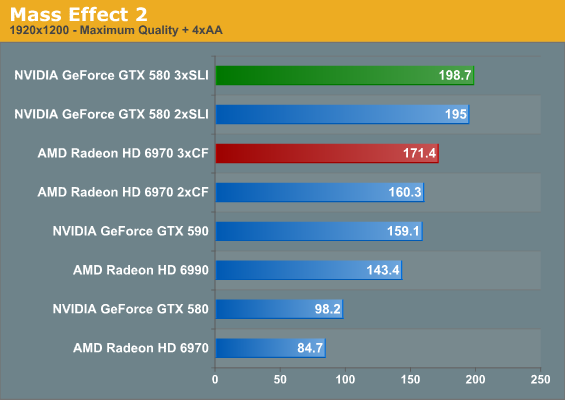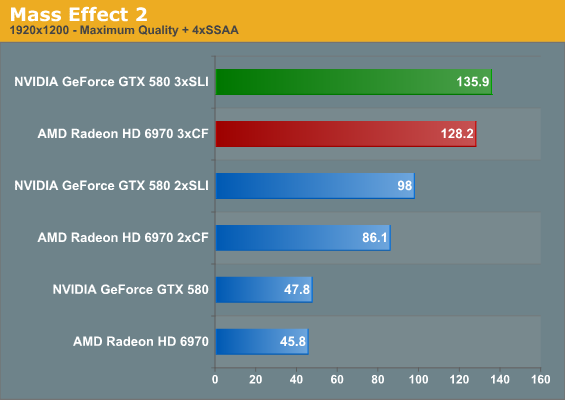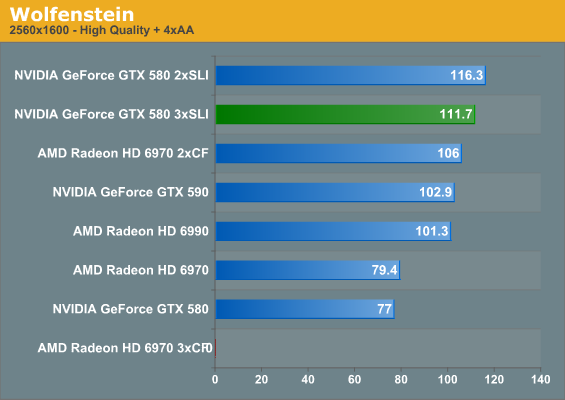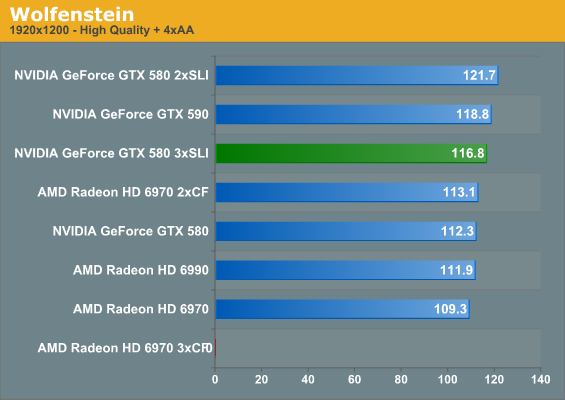A Look At Triple-GPU Performance And Multi-GPU Scaling, Part 1
by Ryan Smith on April 3, 2011 7:00 AM ESTMass Effect 2, Wolfenstein, and Civ V Compute


Mass Effect 2 is a game we figured would be GPU limited by three GPUs, so it’s quite surprising that it’s not. It does look like there’s a limit at around 200fps, but we can’t hit that at 2560 even with three GPUs. You can be quite confident with two or more GPUs however that your framerates will be nothing short of amazing.

For that reason, and because ME2 is a DX9-only game, we also gave it a shot with SSAA on both the AMD and NVIDIA setups at 1920. Surprisingly it’s almost fluid in this test even with one GPU. Move to two GPUs and we’re looking at 86fps – again this is with 4x super sampling going on. I don’t think we’re too far off from being able to super sample a number of games (at least the console ports) with this kind of performance.


Wolfenstein is quite CPU limited even with two GPUs, so we didn’t expect much with three GPUs. In fact the surprising bit wasn’t the performance, it was the fact that AMD’s drivers completely blew a gasket with this game. It runs fine with two GPUs, but with three GPUs it will crash almost immediately after launching it. Short of a BSOD, this is the worst possible failure mode for an AMD setup, as AMD does not provide individual game settings for CF, unlike NVIDIA who allows for the enabling/disabling of SLI on a game-specific basis. As a result the only way to play Wolfenstein if you had a triple-GPU setup is to change CrossFire modes globally, which requires a hardware reconfiguration that takes several seconds and a couple of blank screens.
We only have one OpenGL game in our suite so we can’t isolate this as an AMD OpenGL issue or solely an issue with Wolfenstein. It’s disappointing to see AMD have this problem though.

We don’t normally look at multi-GPU numbers with our Civilization V compute test, but in this case we had the data so we wanted to throw it out there as an example of where SLI/CF and the concept of alternate frame rendering just doesn’t contribute much to a game. Texture decompression needs to happen on each card, so it can’t be divided up as rendering can. As a result additional GPUs reduce NVIDIA’s score, while two GPUs does end up helping AMD some only for a 3rd GPU to bring scores crashing down. None of this scores are worth worrying about – it’s still more than fast enough for the leader scenes the textures are for, but it’s a nice theoretical example.
| Radeon HD 6970 | GeForce GTX 580 | |||||
| GPUs | 1->2 | 2->3 | 1->3 | 1->2 | 2->3 | 1->3 |
| Mass Effect 2 | 180% | 142% | 158% | 195% | 139% | 272% |
| Mass Effect 2 SSAA | 187% | 148% | 280% | 198% | 138% | 284% |
| Wolfenstein | 133% | 0% | 0% | 151% | 96% | 145% |
Since Wolfenstein is so CPU limited, the scaling story out of these games is really about Mass Effect 2. Again dual-GPU scaling is really good, both with MSAA and SSAA; NVIDIA in particular achieves almost perfect scaling. What makes this all the more interesting is that with three GPUs the roles are reversed, scaling is still strong but now it’s AMD achieving almost perfect scaling on Mass Effect 2 with SSAA, which is quite a feat given the uneven scaling of triple-GPU configurations overall. It’s just a shame that AMD doesn’t have a SSAA mode for DX10/DX11 games; if it was anything like their DX9 SSAA mode, it could certainly sell the idea of a triple GPU setup to users looking to completely eliminate all forms of aliasing at any price.
As for Wolfenstein, with two GPUs NVIDIA has the edge, but they also had the lower framerate in the first place. Undoubtedly being CPU limited even with two GPUs, there’s not much to draw from here.










97 Comments
View All Comments
masterchi - Sunday, April 3, 2011 - link
"Going from 1 GPU to 2 GPUs also gives AMD a minor advantage, with the average gain being 182% for NVIDIA versus 186% for AMD"This should be 78.6 and 87.7, respectively.
Ryan Smith - Sunday, April 3, 2011 - link
To be clear, there I'm only including the average FPS (and not the min FPS) of all the games except HAWX (CPU limited). Performance is as the numbers indicate, 182% and 186% of a single card's performance respectively.eddman - Sunday, April 3, 2011 - link
Doesn't make sense. Are you saying that, for example, 580 SLI is 2.77 times faster than a single 580?SagaciousFoo - Sunday, April 3, 2011 - link
Think of it this way: A single 580 card is 100% performance. Two cards equals 186% performance. So the SLI setup is 14% shy of being 2x the performance of a single card.AnnihilatorX - Sunday, April 3, 2011 - link
This is typical percentile jargon. It's author's miss really.When you say 186% average gain, you mean 2.86 times the performance.
When you say 86% average gain, you mean 186% the performance, and that's what you mean.
The keyword gain there ais unecessary and misleading.
80% increase -> x 1.8
180% increase -> x 2.8
SlyNine - Sunday, April 3, 2011 - link
Correct, it should read, 186% of (multiplication) a single card.But I am making the assumption that gain means addition.
DaFox - Sunday, April 3, 2011 - link
That's unfortunately how it works when it come to multi GPU scaling. Ryan is just continuing the standard trend set by everyone else in the industry.Bremen7000 - Sunday, April 3, 2011 - link
No, he's just using misleading wording. The chart should either read "Performance: 186%" or "Performance gain: 86%", etc. This isn't hard.sigmatau - Monday, April 4, 2011 - link
The OP is correct. You cannot use "gain" and include the 100% of the first card. This is simple percentages.If I have one gallon of gas in my car and add one gallon, I gain 100%.
I also have a total of 200% of what I had at the start.
Kaboose - Sunday, April 3, 2011 - link
Finally, it has taken awhile but finally and thank you!!! Multi-monitor is exactly what we need in these reviews, especially the 6990 and 590 reviews.